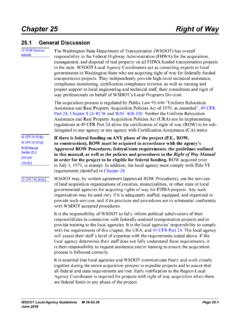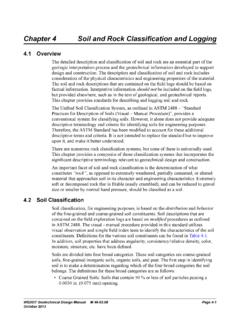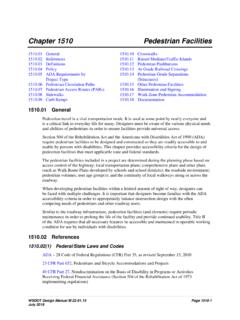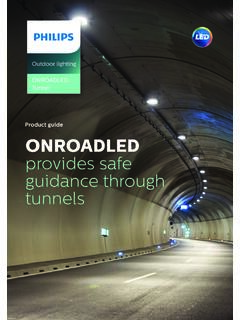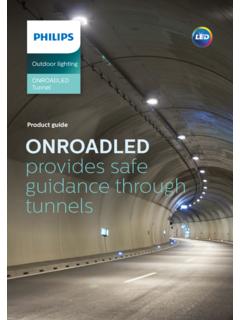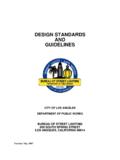Transcription of Chapter 1040 Illumination
1 Chapter 1040 Illumination General Definitions Design Considerations Required Illumination Additional Illumination Design Criteria Documentation References General Illumination is provided along highways, in parking lots, and at other facilities to enhance the visual perception of conditions or features that require additional motorist, cyclist, or pedestrian alertness during the hours of darkness. The Washington State Department of Transportation (WSDOT) is responsible for Illumination on state highways and crossroads (WAC 468-18-040 and WAC 468-18-050) with partial limited access control, modified limited access control, or full limited access control, regardless of the location. WSDOT is responsible (WAC 468-18-050) for Illumination on state highways and crossroads with managed access control located outside the corporate limits of cities.
2 Cities are responsible for Illumination on managed access state highways within their corporate limits. For the definitions of limited access control and managed access control, see Chapter 520. For a listing (by milepost) of the limited access or managed access status of all state highways, refer to the Access Control Tracking System Limited Access and Managed Access Master Plan, under the More Information heading: For further information, refer to the WSDOT/Association of Washington Cities agreement City Streets as Part of State Highways : Definitions The following terms are defined in the Glossary: adaptive lighting system, average light level, complex ramp alignment and grade, continuous load, footcandle (fc), lamp lumens, light emitting diode(LED), long tunnel , lumen, luminaire, luminance, luminous flux, maximum uniformity ratio, maximum veiling luminance ratio, minimum average light level, minimum light level, mounting height luminaire, multimodal connection, negative Illumination , nighttime, pedestrian crossing, pole height (H1), positive Illumination , roadway luminance, security lighting , short tunnel , SIgnal Maintenance Management System (SIMMS), slip base, spacing, transit flyer stop, transit stop, uniformity ratio, and veiling luminance.
3 Design Considerations An Illumination system is built from many separate components. The simplest Illumination system contains the following: A power feed from the local utility company. WSDOT Design Manual M Page 1040-1. July 2017. Illumination Chapter 1040. An electrical service cabinet containing a photocell and circuit breaker for each Illumination circuit. Runs of conduit with associated junction boxes leading to each luminaire. Conductors routed from the service cabinet breaker to each luminaire. A concrete light standard foundation. A light standard with a slip base or a fixed base. A luminaire (light) over or near the roadway edge line. There are design considerations that need to be addressed when performing even the most minimal work on an existing Illumination system. An existing electrical system is acceptable for use under the design requirements and National Electric Code (NEC) rules that were in effect at the time of installation.
4 When modifying an existing electrical service or transformer, the designer is responsible for bringing the whole system up to current NEC design standards. Retrofitting an existing fixed base light standard with a slip base feature requires the installation of quick disconnect fittings and fuses in the circuit, at the luminaire only. The existing conductor configuration for a fixed base luminaire is not acceptable for use on a breakaway (slip base). installation. Existing conductors and components that no longer meet current NEC requirements are to be replaced and the whole circuit is to be designed to current standards. This may mean replacing the whole circuit back to the nearest overcurrent protection device (circuit breaker). Address the following when modifying an existing Illumination system: Whether the existing circuit is in compliance with current NEC standards (deficient electrical component).
5 Whether existing luminaire system components, such as conductors, conduit, junction boxes, foundation, and pole comply with current standards. Whether conductors meet NEC requirements for temperature rating (deficient electrical component). Conductor material: aluminum conductors or copper conductors (deficient electrical component). Whether the existing bonding and grounding system is adequate: cabinets, poles, junction boxes, including lids, and other appurtenances are bonded and grounded per NEC requirements. The condition and adequacy of the existing conduit running between the luminaire and the nearest junction box (deficient electrical component). The condition of the junction box next to the luminaire (deficient electrical component). The suitability of the existing foundation to meet current design requirements. The suitability of the location to meet current design standards for Illumination .
6 The location and bolt pattern of the existing foundation to meet current design standards. The design life remaining for the existing light standard (deficient electrical component). The condition of the existing light standard (deficient electrical component). Page 1040-2 WSDOT Design Manual M July 2017. Chapter 1040 Illumination Maintenance personnel assessment of the electrical safety of the installation. Involve appropriate Headquarters (HQ) and region Traffic Office design personnel early in the process. Ensure potential system deficiencies are reflected in the estimate of work. Maintain required Illumination during all construction activities, except when shutdown is permitted to allow for alterations or final removal of the system per the Engineer. Site preparation, widening, drainage, guardrail installation, or other work can easily impact existing conduit runs or luminaire locations.
7 Also, changed conditions such as merging, weaving, or unusual alignment due to traffic control often require additional temporary Illumination . Note: The same lighting requirements apply whether a condition is temporary or permanent. Illumination is not required for minor operational enhancement projects, unless that is the specific reasoning for the project. Required Illumination The following items are to be considered for each project: Replace standard duty junction boxes that are located in paved areas with heavy-duty junction boxes, and bring electrical components to current standards. Relocate/remove junction boxes that are located in the travel way when practical. Review the age of the equipment as listed in SIMMS and consider replacing components that have reached the end of their design life. Replace poles, foundations, heads, and other equipment, that have reached their design life.
8 Locate components so that they can be safely accessed from the right of way. Ensure existing slip base features are in accordance with current design standards. Consider additional Illumination in accordance with , if warranted, or design additional Illumination if it is called for in the Project Definition. When it is necessary to relocate existing light standard foundations, evaluate the entire conduit run serving those light standards and replace deficient components to current (NEC) standards. Exhibits 1040-1a through 1040-21 show examples of Illumination for roadway, transit flyer stops, parking lots, truck weigh stations, tunnels, bridges, work zones, and detour applications. A minimum of two light standards of standard pole height are required at all design areas, with the exception of some ramp terminals, entrance/exit points at minor parking lots, and basic transit stop lighting .
9 (1) Freeway Off-Ramps and On-Ramps Provide the necessary Illumination for the design area of all freeway off-ramp gore areas and on-ramp acceleration tapers (see (2) and Exhibits 1040-1a, 1b, and 1c). (2) Freeway Ramp Terminals Provide the necessary Illumination for the design area (see Exhibit 1040-2). Ramp terminals may use a single light standard where all of the following are true: WSDOT Design Manual M Page 1040-3. July 2018. Illumination Chapter 1040. The ramp terminal is stop controlled (no traffic signal). The on and off-ramps are a single lane, regardless of width. The cross street is two lanes with no channelization. There are no sidewalks or marked crosswalks. Verify with the HQ Traffic Office that the location is acceptable for a single light standard. (3) Freeway On-Ramps With Ramp Meter Signals Provide the necessary number of light standards to illuminate freeway on-ramps with ramp meters, from 150' before the ramp meter stop bar to 50' past the ramp meter stop bar.
10 When there is an HOV bypass lane or a two-lane merge beyond the ramp meter, then also provide Illumination from the point where the merging lane width is 10' to 200' downstream of that point (see Exhibit 1040-3). Illumination for the ramp merge with mainline is to be done per Exhibit 1040-1b. (4) HOT (High-Occupancy Toll) Lane Enter/Exit Zones and Access Weave Lanes Provide the necessary number of luminaires to illuminate the design area of the enter/exit zones and access weave lanes of the HOT lane (see Exhibits 1040-4a and 4b). (5) Lane Reduction Provide the necessary number of light standards to illuminate the design area of all highway lane reduction areas within the urban boundary (see Exhibit 1040-5). This requirement does not apply to: The end of slow-moving vehicle turnouts. The end of the area where driving on shoulders is allowed.

